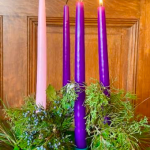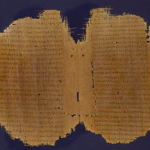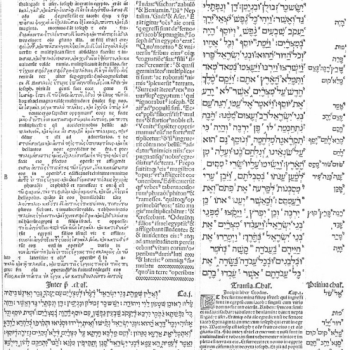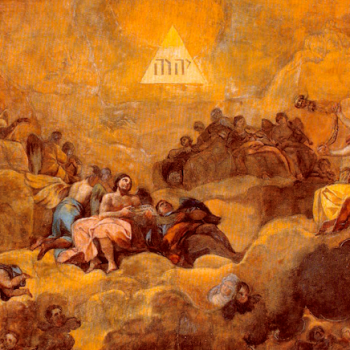John 1.6-8, 19-28 (RSV-CE)
There was a man sent1 from God, whose name was John. He came for testimony, to bear witness2 to the light, that all might believe through him. He was not the light, but came to bear witness to the light. …
And this is the testimony of John, when the Jews sent priests and Levites from Jerusalem to ask him, “Who are you?” He confessed, he did not deny, but confessed, “I am not the Christ.”3 And they asked him, “What then? Are you Elijah?” He said, “I am not.” “Are you the prophet?” And he answered, “No.” They said to him then, “Who are you? Let us have an answer for those who sent us. What do you say about yourself?” He said, “I am the voice of one crying in the wilderness, ‘Make straight the way of the Lord,’4 as the prophet Isaiah said.”
Now they had been sent from the Pharisees. They asked him, “Then why are you baptizing,5 if you are neither the Christ, nor Elijah, nor the prophet?” John answered them, “I baptize with water; but among you stands one whom you do not know, even he who comes after me, the thong of whose sandal I am not worthy to untie.” This took place in Bethany6 beyond the Jordan, where John was baptizing.

John 1.6-8, 19-28 (my translation)
There was a man sent1 by God whose name was John. He came for testimony, to give testimony2 about the light, so that everyone would believe on account of him. This man was not the light, but came to give testimony about the light. …
Now this is the testimony of John, when the Jews sent priests and Levites to him from Jerusalem to ask him: “Who are you?” And he admitted and did not deny, and admitted that “I am not the Anointed.”3
And they asked, “Then who? Are you Elijah?” And he said, “I am not.” “Are you the Prophet?” And he answered: “No.” So they said to him, “Who are you? So that we may give an answer to those who sent us; what have you to say for yourself?” He said: “I am a voice shouting in the desert, ‘Make way for the Lord,’4 just as Isaiah the prophet said.” Now, those who had been sent were from among the Pharisees, and they asked him and said to him, “Then why do you perform immersions,5 if you are neither the Anointed nor Elijah nor the Prophet?”
John answered them, saying: “I perform immersions in water; in the middle of you stands one whom you do not know, who comes behind me; I am not worthy, no, not to loosen the strap of his sandal.” (These things happened in Bethany-over-the-Jordan,6 where John was performing immersions.)
I’ve my usual textual notes on this Gospel, six in all, which are addressed in the section further down creatively named “Numeric Textual Notes.” I made three other notes as well, which were initially also on individual textual points; however, they ballooned so much that I decided to discuss them separately, especially since they have broad application throughout the Fourth Gospel.
Johannine Motifs: 1. Christ on Trial
The first one that came up had to do with the term homologeō [ὁμολογέω], which the RSV translates “confess” and which I instead gave as “admit”; it literally means “to say the same, think the same, agree.” Confess is the conventional translation, and in some ways suits this text nicely, because one of the most persistent themes in John, expressed in a myriad of ways, is that of a trial. Listen for words like witness, judge, truth, belief, condemn, and their many derivatives and synonyms; note, too, that the cleansing of the Temple—which evokes Holy Week and therefore the imminent trial of Jesus, especially since it was on grounds of a statement he then made about the Temple that he was ostensibly convicted—is presented to us as early as chapter 2 (almost like a flash forward). Furthermore, the passage overall is the cross-examination of a witness, the Baptist, by members of what was then still an existent body with legal powers, i.e. the Sanhedrin (which was not disbanded until the mid-fourth century). I don’t know, but I also have a hunch that the recurring use of sign and glorify may be linked in some way to Greek or Jewish legal practice, relating to evidence and exoneration respectively.

Likewise in English, confess indicates (on the whole) that we’re discussing matters of a particular register. Register is an important topic in sociolinguistics; it indicates an expected vocabulary, tone, style, and topic or range of topics, depending on the setting and/or audience. Some people have many registers at their command, others fewer, but everyone speaks a little bit differently depending on context. Confess is a good example of a word with strong ties to the religious and legal domains. If we wanted a synonym, we’d probably reach for say, speak, or talk (all fairly register-neutral); if we specifically wanted one in a different register, we might use vouchsafe (fantastic or poetic register) or pinky-swear (childhood register).
Why, then, did I decide against this seemingly-excellent translation? Because homologeō has a much wider range of appropriate contexts than the two registers confess indicates, and lacks some of the corresponding connotations. You can “confess” a secret, or a faith, or a crime; you can’t “confess” that this cake is delicious or that that movie was top-notch, not without sounding like you’re making a joke at least. Admit, on the other hand, while it still carries a tinge of the moral sphere (as in a phrase like “I just wish he would admit it”), can be used in many registers without sticking out.
Johannine Motifs: 2. John the Baptist
This passage hints at how great an impact St. John the Baptist made in the first century. At the time, he was very widely known. He is one of the few figures other than Jesus, Mary, and the Twelve to appear by name in all four Gospels; St. Paul met disciples of the Baptist as far afield as Ephesus; and the historian Josephus, half a century after the time of the Gospels, devotes more space to him than to his slightly younger cousin, Jesus. The Synoptics give briefer accounts of the Baptist’s ministry—perhaps because it was so well-known as to call for little comment. Only John, as far as I recall, informs us that several of the earliest disciples of Jesus were disciples of St. John the Baptist first.
Yet even this tells us less than the truth. Consider the modern Mandæan faith. The Mandæans are a small ethnoreligious group from southern Iraq, somewhere close to a hundred thousand people at most. They mostly fled their native territory when the US invaded in 2003; the diaspora is now located chiefly in Western Europe, Australasia, and the US, along with several thousand still in the Near East. Mandæism is generally classified as a type of Gnosticism. I’m not sure how to judge the accuracy or usefulness of that classification, since it is a closed religion—i.e., not only are converts discouraged, as in typical Judaic practice, but conversion to the Mandæan faith is not provided for nor countenanced at all. (I’ve read that the possibility of opening Mandæism to converts has been broached recently, due to the massive population shift from the Near East to Western countries, which in turn prompts both interest from local Westerners and increased intermarriage between Mandæans and outsiders. However, I gather it remains a contentious idea.) And the most esteemed prophet of this faith? Not Jesus—whom they consider to have been a priest of theirs who went renegade—but John the Baptist.
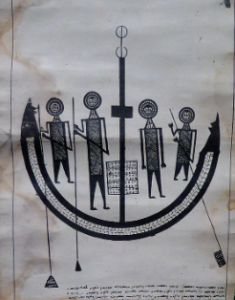
A selection from the Scroll of Abatur,
an illustrated sacred text of Mandæism.
Photographed by Ethan Doyle White (source).
I’m given to understand that the Baptist retains more of this prominence in the Christian East, e.g. that the ikonostasis (a barrier between what would be the nave and the sanctuary in a Latinate church) must include ikons of the Blessed Mother and the Baptist. Exactly why he seems to have been relatively deëmphasized in the West, I don’t know.
Johannine Motifs: 3. The Pharisees
The role of the Pharisees in first-century Judæa is frequently misunderstood by modern Christians, especially since Pharisee is, in some Christian circles anyway, a synonym for religious hypocrite. This is rather unfortunate, not only for the, shall we say, infelicitous way in which it has influenced Christian-Judaic relations throughout history, but because it obscures the real significance of many texts in which the word occurs, and even the ministry of Jesus itself.
The Pharisees were a theological (and, to a far lesser extent, political) party of Judaism during the Second Temple period, dating roughly from 516 BCE to 70 CE. We meet a few of their rivals in the Gospels as well, principally the Sadducees and the Zealots; those who’ve read a bit in New Testament studies will likely have come across the Essenes as well, generally believed to be the group that composed the Dead Sea Scrolls.* Politically, the Sadducees were collaborators with the Herodian dynasty, and with the Romans accordingly; they were a more or less exclusively wealthy sect, found largely among the priests (though not all priests were Sadducees by any means). The Zealots favored armed resistance to the Romans, taking inspiration from the Maccabee revolt a century and a half before. The Essenes—who may have influenced St. John the Baptist—were reclusive, apocalyptic millenarians who seem to have abandoned the cultus of the Temple, believing it hopelessly riddled with corruption. They joined in the Jewish War of 66-73, in which they were almost if not completely obliterated; the same happened to the majority of Palestinian Judaic groups in that war and the Bar Kochba Revolt of 132-135.
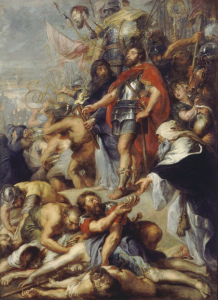
Peter Paul Rubens, The Triumph of Judah Maccabee, 1636.
The Pharisees (who also happen to be the most important group that survived both wars) were different. They believed God would deliver the Jews from foreign dominion, if they simply devoted themselves to the study and practice of the Torah; they also seem to have been the most popular of the Judaic parties in the Holy Land itself. Their political quietism seems to have been linked with their belief in the Oral Torah, a set of interpretive principles for understanding and applying the Written Torah handed down by word of mouth, both of which the Pharisees believed had been given by God to Moses at Sinai. The Mishnah, which later became the first portion of the Talmud, was a compendium of Oral Torah material, first created around the year 200—it isn’t likely to be identical to the variety of Oral Torah current in Palestine during the life of Jesus, but it isn’t likely to be very far from it, either. It may be for this reason that the Pharisees were prepared to embrace a wider canon, of both sacred books and accepted doctrines, than their main academic opponents, the Sadducees: where the Saducees acknowledged only the Torah itself as divine and did not believe in immaterial spirits (either human or angelic), the Pharisees used roughly the Hebrew Bible as it is known today,** and believed in both the human soul and an intricate hierarchy of angels.
But one of the most significant things about the Pharisees is something you’ll very rarely see in a homily or the notes of a study Bible: Jesus was a Pharisee. (I’m not sure why this is so little understood. Typically I’d assume that an omission like this was caused by Christian anti-Semitism, and that may indeed be the reason, but I haven’t looked into it yet.) He certainly diverged from fellow Pharisees in several important respects, favoring a generally less demanding and somewhat less ritualized interpretation of the Oral Torah; and he was clearly unpopular as a person with a great many Pharisees, which is apt to result from calling a lot of respectable clergymen hypocrites! But many of his key beliefs and those of his earliest followers—the wider canon, the existence of angels, the reality of the soul, the role of the Messiah, and the Last Day, featuring both the resurrection of the dead and the judgment of all mankind—these were all Pharisaic doctrines. Moreover, the points on which he argues with the Pharisees about interpreting and applying the Torah tend to be ritual points: appropriate conduct on the sabbath, necessary versus optional ablutions, the correct use of oaths, etc. Debates like that, with some exceptions, are most often held within a given community, rather than between one community and another.
Numeric Textual Notes
1. The word sent here translates apestalmenos [ἀπεσταλμένος], which is related to our word apostle—literally “sent one,” idiomatically “ambassador, emissary.”
2. English is a little inconvenient here. In Greek, the stem martür- [μάρτυρ-], “witness,” is the root of all the verbs, nouns, and adjectives for that concept that you’re likely to find in the New Testament. English, on the other hand, distributes these terms between two stems, witness and testi-, somewhat randomly: e.g., a witness has witnessed something and then bears witness about it, but what they tell you isn’t called “witnessry”; it is testimony, as the act of giving it is testifying and (when written down) the content is a testament, but the person who gave it isn’t a “testificier” (however cool that might sound). The rhetorical effect of John’s Gospel depends partly upon frequently-repeated stems, and in this case it’s difficult to convey those repetitions in full, except by reaching for really arcane vocabulary.
3. Christ is one of the problem-words of the New Testament. When it was translated from Greek into Latin, certain words and names were not translated but simply transliterated—e.g. angelus, apostolus, Christus, evangelium, Petrus. The same sort of thing had happened in translation from Hebrew and Aramaic to Greek, and many of these words were again kept semi-Hebraic in Latin: for instance, hallelujah (or alleluia in its more Latinized form), amen, Sabaoth, and the angelic names of the cherubim and seraphim.† Perhaps these words had been borrowed in any case, or maybe they were felt to be technical vocabulary and so marking them in some way was considered desirable. Regardless, the same procedure was applied to these words in English; they were not translated, but merely Anglicized: alleluia, amen, angel, apostle, cherubim, Christ, evangel, Peter, Sabaoth, seraphim, etc.
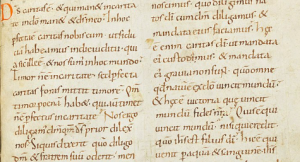
But the meaning of Christ, as you may know already, is “Anointed” or “the Anointed One” (related to the English chrism, i.e. holy oil). The ritual practices of ancient Semitic monarchies were in several respects unlike those we are familiar with from Medieval and Modern European history; for example, the queen was almost never the king’s wife (or rather, one of his wives, which may suggest one of the reasons behind this practice!), but was instead the king’s mother, who literally embodied the continuity of the dynasty. Another difference was the important role of anointing with oil, which had a range of cultural meanings. In Judaic practice, possibly derived from Egypt, to anoint someone with oil was to designate them an official deputy or messenger: as reflected in Psalm 2, which may have been sung at coronations, the King of Judah was “the Lord’s anointed” because he was descended from David, whom God had personally chosen to be the king, and was now the representative of the Lord in turn. “The Christ” would, therefore, sound to a Greek-speaking Jew of the first century a little bit like the phrase “the Prince Regent” does to us.
4. I decided to use a slightly more idiomatic phrase “make way for,” as we occasionally see employed in fictitious depictions of Near Eastern or pseudo-Near Eastern societies. (This clip does not quite illustrate it, but it’s from an excellent and very sadly neglected film, so I’m linking it anyway). A more literal rendering would be “straighten the Lord’s path,” which is a phrase we don’t use in English but obviously means the same thing.
5. The word “baptize” has exclusively religious (and almost exclusively Christian) connotations in English. The same is not true of the Greek baptizō [βαπτίζω], which simply means “to dip, dunk, immerse,” and was a perfectly ordinary word—in John 13.26, when Jesus tells John that the one who will betray him is the one “to whom I will give this morsel after I have dipped it,” the word for “dip” is a slightly-altered form of the same term. I’ve therefore chosen to render it immerse instead.

Photographic postcard of the Jordan River, ca. 1925.
6. Some translations (notably the King James) replace Bethany here with Bethabara. This seems to be traceable to a comment made by Origen (a church father and renowned Biblical scholar from the early third century, who spent most of his life in Egypt and Palestine), that—at any rate in his day—there was no town called Bethany on the east side of the Jordan, and proposed that Beyth ‘Anyah [בית עניה] might be an error for Beyth ‘Abarah [בית עברה], meaning “house of the ford” or “place of crossing,” which might be the name of either a town or just a particularly good spot to ford the Jordan River. However, the oldest and best manuscripts (as far as I was able to look up) do seem to prefer Bethany; and a couple of centuries—especially a couple of centuries that had large-scale local wars in—would be plenty of time for even a modestly large town to be destroyed or depopulated.
Footnotes
*Other Judaic groups also existed, especially outside Palestine. Alexandria on the Egyptian coast had an especially large Jewish population, and the Alexandrian scholar Philo (heavily influenced by Platonism) is representative of Hellenistic Judaism, or at least of some strand within it. In the Holy Land itself, the only other group of note appears to have been the Samaritans; whether or to what extent they resembled any of the other groups, I don’t know.
**Though differently arranged, this is equivalent in content to the Protestant form of the Old Testament. The Catholic, Ethiopic, and Orthodox Old Testament canons differ from the Hebrew Bible, as well as from one another. Catholics add Tobit, Judith, I and II Maccabees, Sirach, Wisdom, and Baruch, as well as some extra material in the books of Esther and Daniel; the Orthodox canon adds all these and also III Maccabees, Psalm 151, the Prayer of Manasseh, and I Esdras. (This book is also given the title “Greek Ezra” and a few more besides; if you ever truly have absolutely nothing to do, try and make sense of the four books called Esdras, which are all numbered differently and have a different authoritative status, depending on the language and tradition you’re working in). The Ethiopic canon is the largest: it contains nearly everything in the Orthodox canon except the two books of Maccabees, and also pulls in IV Esdras (a.k.a. the Apocalypse of Ezra), Jubilees, I Enoch, I, II, and III Meqabyan, and a peculiarly Ethiopic version of Lamentations, as well as often including an appendix, considered non-inspired but edifying, called Josippon (due to an erroneous tradition that it had been authored by Josephus).
†Curiously, these were borrowed specifically in the plural form, though this fact was lost at some point, and also saw their final consonant changed from m to n. This may have been under the influence of Aramaic, the actual lingua franca of the Jews when the Hebrew Bible was first translated into Greek, which has plurals in –in instead of –im; or it might have been thanks to Greek phonetics, which favor final –n over final –m. Regardless, if you’re ever reading a book in English that’s more than a century or two old, and you see them discussing the “seraphins,” as distinct for example from a single “seraphin,” this is why.


